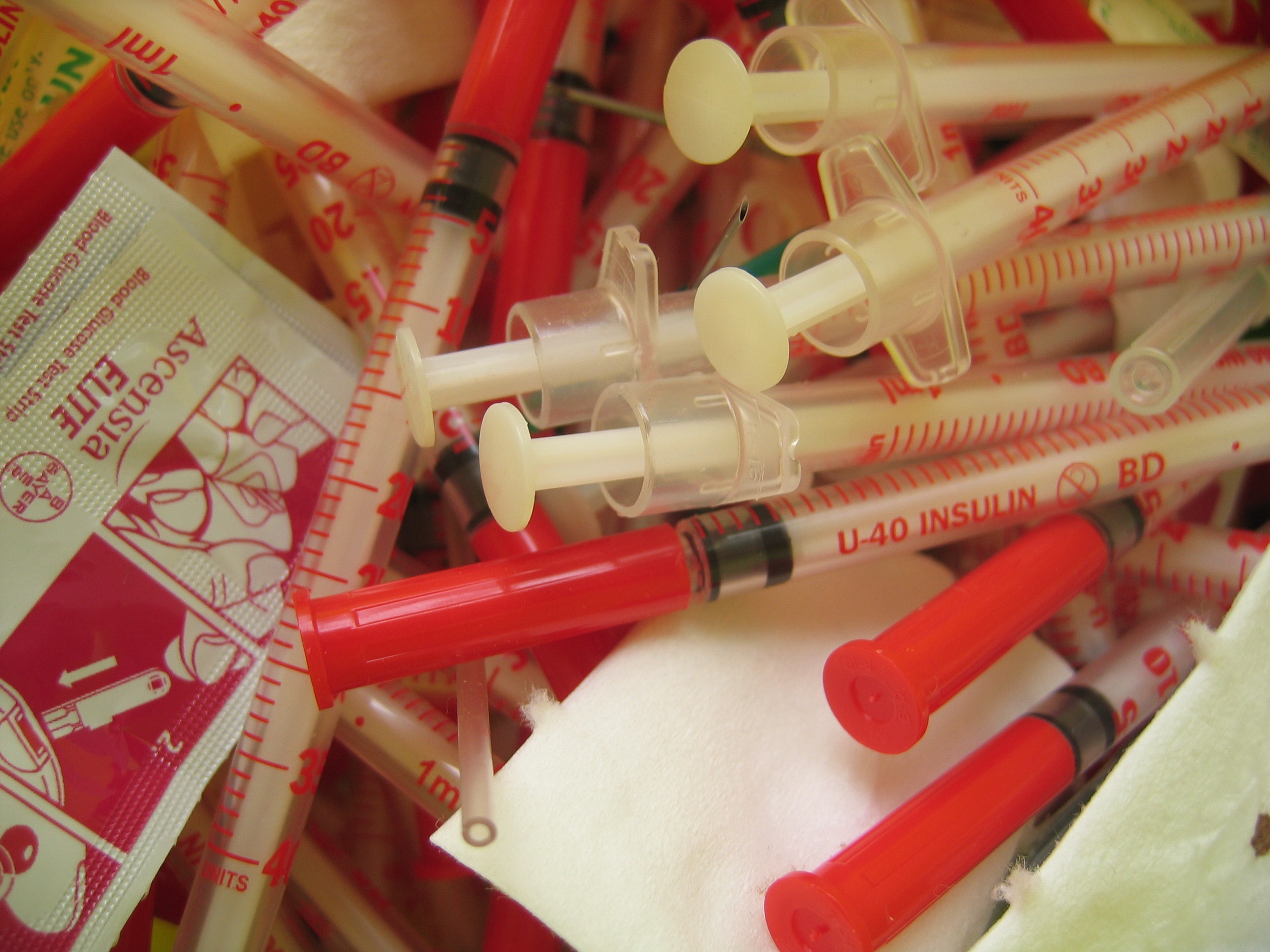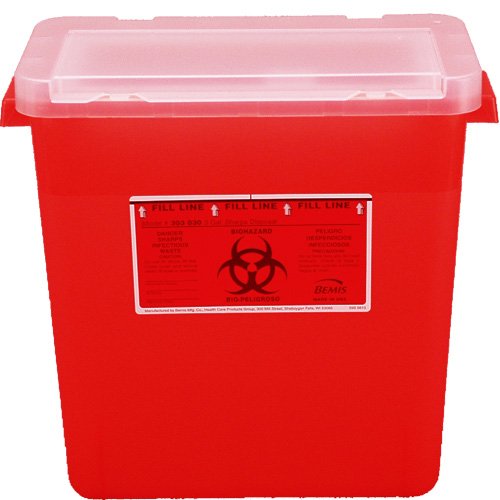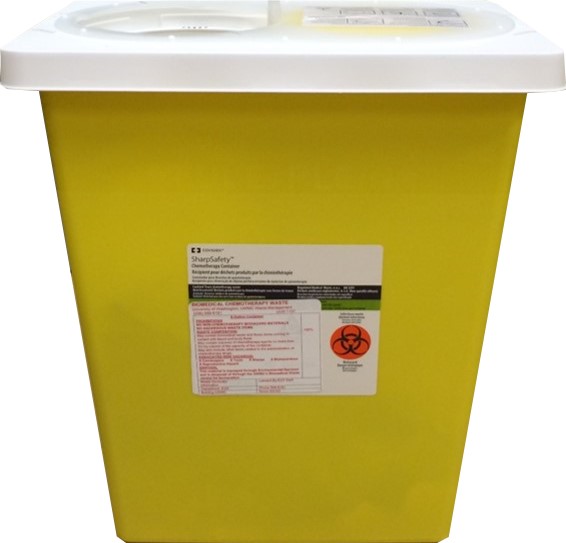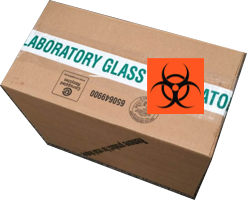Sharps and Lab Glass Waste

Sharps waste is regulated by state law and requires special handling. Sharps are instruments used to puncture or cut body parts. In a waste container, sharps can cause cuts, punctures and potential exposure to waste handlers.
Laboratory glass and plastic waste are not technically sharps but can puncture regular waste bags and injure waste handlers. The rules for packaging and disposal of laboratory glass and plastic waste differ depending on whether or not the items are contaminated.
Visit the Sharps Safety webpage and review the Work Safely with Sharps Focus Sheet to learn more about safe handling of sharps and options for sharps substitution.
Sharps Waste
Sharps waste is regulated by state law and must be separated from the regular waste stream. The term “sharps” refers to items used to puncture or cut body parts. In a waste container, sharps can cause punctures, cuts and potential exposure to waste handlers. Therefore, all sharps waste must be placed in sharps containers and decontaminated prior to disposal.
The following are always sharps waste:
- Needles, syringes with needles and IV tubing with needles attached
- Lancets
- Scalpel blades
The following are defined as sharps waste if they are contaminated with a biohazard (including recombinant or synthetic DNA/RNA):
- Broken glass
- Razor blades
- Fragile glass items like tubes, vials, ampoules and Pasteur pipettes
- Glass slides and cover slips
Use the Packaging Sharps and Lab Glass Waste poster to help identify your waste.

Place sharps waste in red plastic sharps containers labeled with the biohazard symbol. Choose a container size that fits your work space; do not use a container that is too large. When the container is no more than two-thirds full, close the lid and place autoclave tape over the lid and sides without blocking the vent holes. Label with Principal Investigator (PI) name and room number.
Sharps containers are available for purchase from Biochemistry Stores or from lab/medical vendors through UW Procurement Services.
Sharps containers must be decontaminated prior to disposal regardless of whether the items inside are contaminated with biohazards. If a sharps container is punctured or has needles sticking out, place the entire container inside a larger sharps container; do not attempt to empty.
Refer to the information on the Biohazardous Waste page for decontamination of biohazardous waste. EH&S does not collect sharps containers. Check with your department to see if a sharps disposal waste stream already exists.

Place sharps contaminated with chemotherapy (chemo) or hazardous drugs in a yellow sharps container with a biohazard symbol. Do not autoclave yellow trace chemo sharps containers. Follow the instructions for packaging and disposal on the Chemotherapy and Hazardous Drugs page. Use the Sharps Waste poster for help.
Biohazardous lab glass and plastic
Biohazardous lab glass and plastic includes items contaminated with biohazards (including recombinant or synthetic DNA/RNA) that could puncture a plastic bag. These items are not considered sharps but are capable of puncturing bags:
- Micropipette tips
- Serological pipettes
- Syringes without needles
- Test tubes, swabs and sticks
- Any contaminated item that is not a regulated sharp but could puncture a biohazard bag
Use the Packaging Sharps and Lab Glass Waste poster to help identify your waste.

These items are not considered sharps but do need to be packaged to prevent punctures. Place contaminated plastic pipettes and tips in a container that cannot be punctured and can be easily autoclaved, such as a pipette box/keeper. Or package contaminated items in a sturdy cardboard box lined with a biohazard bag. Label the box with the biohazard symbol and PI name and room number. Seal with “Laboratory Glass” tape, or seal with tape and label as "Laboratory Glass" in large print. Never use cardboard boxes for sharps waste.
Nonhazardous lab glass and plastic
Nonhazardous laboratory glass and plastic waste includes items not contaminated with biohazards that could puncture a plastic bags:
- Micropipette tips
- Serological pipettes
- Syringes without needles
- Test tubes
- Swabs and sticks
- Non-contaminated broken glass, razor blades, fragile glass items including Pasteur pipettes, glass slides and cover slips
- Empty chemical containers

Package nonhazardous lab glass and plastic waste items in sturdy cardboard boxes. Use any sturdy box as long as it will not weigh more than 25 pounds when full. Label boxes with PI name and room number. Then, either seal with “Laboratory Glass” tape, or seal the box with tape, and clearly label as “Laboratory Glass” in large print. Boxes and tape are available in the Chemistry stockroom.
Do not use cardboard boxes for sharps waste, biohazardous waste, liquid waste or chemical containers that cannot be disposed of as regular solid waste. To determine if chemical contamination needs to managed as chemical waste, refer to Empty Chemical Containers. Dispose of glass and plastic contaminated with radioactive material as radioactive waste. Refer to the Radiation Safety Manual for more information.
Nonbiohazardous lab glass is disposed of as garbage. Place the box next to your regular trash container for custodial pick-up.
What you can do to stay safe
- Learn to identify sharps waste vs. laboratory glass and plastic waste.
- Keep sharps waste separate from all other waste streams.
- Sharps waste and biohazardous lab glass and plastic waste must be decontaminated prior to disposal.
- Take the required and recommended safety training courses.
- Learn more about working safely with sharps.
Treatment and disposal of sharps waste and laboratory glass and plastic waste varies based on access to autoclaves and location. Refer to the flow charts on the Biohazardous Waste page for your location for specific treatment and disposal information.
Services available
EH&S biosafety officers can assist with training, consultation and help with any biosafety questions.
Frequently asked questions
EH&S does not collect or treat sharps or other biohazardous waste. EH&S provides consultation and training for on-site or off-site treatment of sharps waste prior to disposal. Refer to the information on the Biohazardous Waste page for decontamination of biohazardous waste. Check with your department to see if a sharps disposal waste stream already exists.
You can purchase Laboratory Glass tape from the Chemistry Research Stockroom in Bagley Hall and from the Life Sciences Building stockroom in B147A. Alternatively, you can clearly label boxes as “Laboratory Glass” yourself.
If your building does not have a personal sharps container, keep them in a sharps container or other rigid container, and then take all of your personal sharps home for disposal.
Follow the guidance for personal sharps disposal for per your county of residence: King County, Pierce County, or Snohomish County.
- DO NOT HANDLE the needle. If you are able to do so, leave a warning sign to help bring it to the attention of others who may pass by.
- Contact UW Facilities Services Customer Care at 206-685-1900. Trained personnel who can safely collect and dispose of needles can respond.
Unopened needles, sharps or other items with needles attached still need to be disposed of in a red hard-sided sharps container with a biohazard symbol. Although unused, the needles still present a hazard to those handling waste. UW Surplus will not accept sharps.




